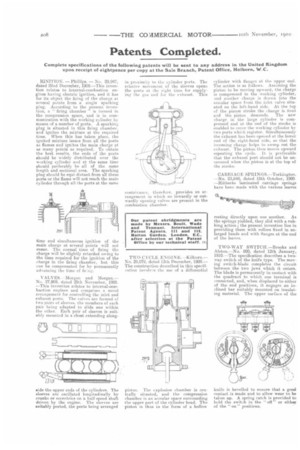Patents Completed.
Page 20

If you've noticed an error in this article please click here to report it so we can fix it.
Complete specifications of the following patents will be sent to any address in the United Kingdom upon receipt of eightpence per copy at the Sale Branch, Patent Office, Holborn, W.C.
IGNITION. — Phillips. — No. 29,947, dated 22nd December, 1909.—This invention relates to internal-combustion engines having electric ignition, and it has for its object the firing of the charge at several points from a single sparking plug. According to the present invention, a " firing chamber " is formed in the compression space, and is in communication with the working cylinder by means of a number of ports. A sparking plug is situated in this firing chamber, and ignites the mixture at the required time. When this has taken place, the ignited mixture issues from all the ports as flames and ignites the main charge at as many points as required. To obtain the beet results, the ends of the ports Ehould be widely distributed over the working cylinder and at the same time should preferably be all of the same length and sectional area. The sparking plug should be equi-distant from all these ports or the flame will not reach the main cylinder through all the ports at the same
time and simultaneous ignition of the main charge a several points will not ensue. The normal time of firing the charge will be slightly retarded owing to the time required for the ignition of the charge in the firing chamber, but this can he compensated for by permanently advancing the time of fir:mr.
VALVES.Morgan and Morgan.— No. 27,809, dated 29th November, 1909. —This invention relates to internal-cornbustion engines and comprises a novel arrangement for contrelling the inlet and exhaust ports. The valves are formed of two pairs -of sleeves, the members of each pair being adapted to slide one within the other. Each pair of sleeves is suitably mounted in a chest extending along
side the upper ends of the cylinders, The sleeves are oscillated longittidinally by cranks or eccentrics on a half-speed shaft driven by the engine. The sleeves are suitably Ported, the ports being arranged in proximity to the cylinder ports. The relative movement of the sleeves opens the ports at the right time for supplying the gas and for the exhaust. This contrivance, therefore, provides an arrangement in which no inwardly or out. wardly opening valves are present in the combustion chamber.
TWOC )(7C LE ENGIN E. —Kilbern.— No. 29,078, dated 13th December, 1Q09.— The construction described in this specifi. cation involves the use of a differential piston. The explosion chamber is centrally situated, and the compression chamber is an annular space surrounding the upper part of the cylinder head. The piston is thins in the form of a hollow cylinder with flanges at the upper end. The action is as follows. Assuming the piston to be moving upward, the charge is compressed in the working cylinder, and another charge is drawn into the annular space from the inlet valve situated on the left-hand side. At the top of the piston stroke the charge is fired aud the piston descends. The new charge in the Large cylinder is compressed and at the end of the stroke is enabled to enter the working cylinder hitwo ports which register. Simultaneously the exhaust has been opened at the lower end of the right-hand side, so that the incoming charge helps to sweep out the exhaust. The piston then moves upward repeating the cycle. It is preferable that the exhaust port should not be uncovered when the piston is at the top of the stroke.
CARRIAGE SPRINGS.—Torkington. --No. 23,840, dated 18th October, 1909. --Hitherto laminated carriage springs have been made with the various leaves resting directly upon one another. As the springs yielded, they slid with a rubbing action ; the present invention lies in providing them with rollers fixed in enlarged heads and with flanges at the end of the leaves.
TWO-WAY SWITCIL—Brooks and Alston.—No. 800, dated 12th January, 1910.—The specification describes a twoway switch of the knife type. The moving switch-blade completes the circuit between the two jaws which it enters. The blade is permanently in contact with the quadrant to which one terminal is connected, and, when displaced to either of the end positions, it engages an inclined bar suitably mounted on insulating material. The upper surface of the knife is bevelled to ensure that a good contact is made and to allow wear to be taken up. A spring catch is provided to held the switch in the " off or eithes of the " on" positions.




















